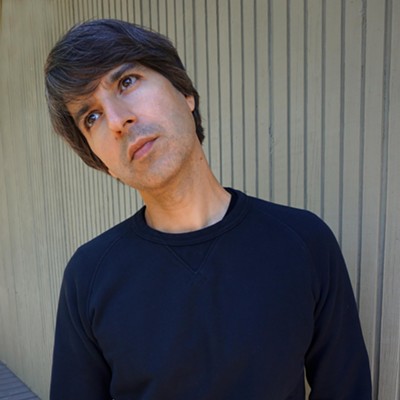Kolomon Sokol's self-admitted darkness is only part of his century-long life. His prolific body of work is on view at the UA Museum of Art--soulful drawings in ink, tempera and charcoal, along with detailed, gloomy woodcuts are an illustrated timeline of the 20th century. Ironically, the show opened a year after the artist died.
"This room contains representative work from eight decades, from the late '20s to the late '90s," says Lee Karpiscak, who, until a year ago, was the assistant director of the UAMA. She's been a longtime friend to the Sokol family and an avid promoter of his brilliance.
"Most of Sokol's work is figurative and has to do with loss, suffering and survival. It's as if he's an historian of the eras and places he lived through," she adds.
Sokol was born in Eastern Slovakia when the last century was just dawning. He went to art school in Prague and then off to Paris on a scholarship, where he met his wife of 70 years. They came to Mexico in 1937, lived for a time in New York City in the mid-'40s and spent a spate of time back in Eastern Europe after the war. Six years were spent in Mexico City. Thirty were spent in Bryn Mawr, Pa. The last 20 or so were lived out on the eastside of Tucson, where Sokol's son looked after them. Sokol's wife, Lydia, is still going strong well into her '90s.
Karpiscak says that Sokol had the good fortune to work in the major art capitals of the world. "If you want to attach him to an art movement, the closest, obviously, would be expressionism. He's the quintessential artist, always in his studio, re-working paintings he began long ago."
His work was influenced by Picasso and cubism, by the Mexican muralists and their monumentality, and by the world around him. His early woodcuts from the 1930s are dark and brooding, with titles like Maddened or Hungry/Starving.
"Perhaps it's the intensity of the blacks and the whites. It's a medium that draws you in," offers Karpiscak of their allure.
The legacy of Sokol's years in Mexico is ubiquitous in his work.
"He met Diego Rivera there," says Karpiscak. "When he went to his studio, he was amazed at how Rivera had all his work laid out for him to see. To have this great artist take time for Sokol, who wasn't so well known yet, really impressed him. He loved those six years in Mexico."
Sokol soaked up his century, its losses and suffering. Revenge of the Bull is a layered, intense woodcut that situates the exploited animal as more powerful than its human oppressors.
"He would always say that he was going to die tomorrow. He was such a pessimist," adds Karpiscak.
Given this negativity, was Sokol happy with his own work?
"That's a good question. Maybe that's one reason he constantly labored over earlier work, spending up to 20 years on one painting. But he did an incredible amount of work over a lifetime. In the end, he was very humble."
Five years before his death, Karpiscak's colleague in Slovakia, Tibor Huszár, published a lengthy monograph of Sokol's work and life. Sokol's visage, full of warmth and grit in his later years, with his shock of white hair and scruffy white beard, stares out of photographs. Images of him puttering in his eastside studio as an old man are emblematic of the voluminous body of work he produced during 80 years. The monograph's introduction captures Sokol's raison d'être.
"He painted because he had to, rejecting convention, fame, time and money. É He's an artist who carries the burden of the downtrodden."
Of his geographic trajectories as an adult, Huszár remarks, "He left Czechoslovakia to spend almost his entire life in Mexico and America. He doesn't even have a passport, nor does he want one. What for? He's an inhabitant of this planet, a tenant of time."
Recognition of Sokol's work, though, seems to have been minimal here in the States. In Slovakia, he's a legend. Karpiscak says he's among three or four people who started modern art there. "Post-communist Eastern Europe opened the door for Sokol. He's had many shows in his home country. In 1998, the monograph came out. There's even a Kolomon Sokol museum in East Slovakia."
Karpiscak describes Sokol as a loner, a very private man.
"He didn't really like people to stop by his studio. When we did the monograph (of which Karpiscak is a contributing writer), we were worried we might be invading his privacy. Then, just before his death, a Slovakian film crew captured some footage for a film. Uncharacteristically, he seemed OK with it."
When the Sokols moved to Tucson and Karpiscak met the artist, she says she recognized how vital Kolomon's art was. "Especially its connection to Mexico. That's what he loved, all those years there. The more I got to know him, I kept thinking, this is the opportunity, while he's still alive, to do this show. Ironically, he died before we could launch it. Hopefully, Peter Briggs (the UAMA curator) will be able to travel it around."
Kolomon Sokol: The Human Spirit is on view through Jan. 25 at the UA Museum of Art located in the fine arts complex at Speedway Boulevard and Park Avenue. Hours are 9 a.m.-5 p.m. Tuesday-Friday and noon-4 p.m. Saturday and Sunday. Admission is free. It's closed during university holidays.
Call for details at 621-7567.







